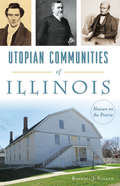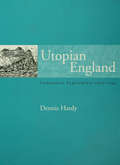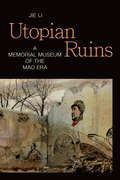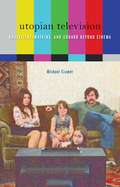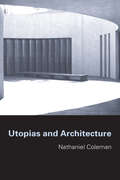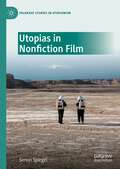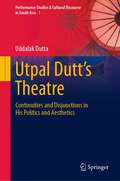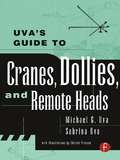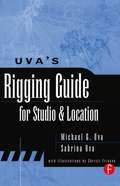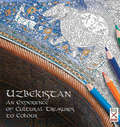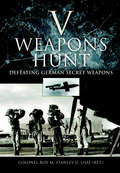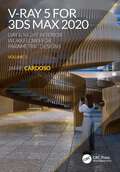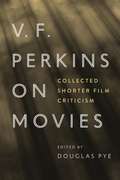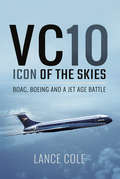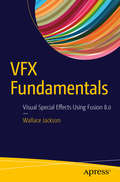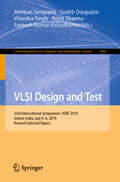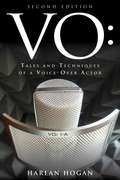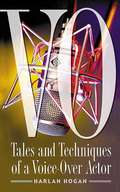- Table View
- List View
Utopian Communities of Illinois: Heaven on the Prairie
by Randall J. SolandThe Prairie State became a crucial testing ground for the grand American thought experiment on how a society should be constructed. Between 1839 and 1901, six different utopian communities chose Illinois as the laboratory and sanctuary to elevate their ideals into reality. The Mormons and the Icarians selected Nauvoo. The Janssonists picked Bishop Hill. The Fourierists settled on the north edge of Loami. The employees of the Pullman Railroad Car Company naturally resided in Pullman, and the Dowietes put down roots in Zion. Three were religious and the others secular. All possessed charismatic leaders and dramatic stories that drew attention from across the globe. Randy Soland examines the relationship between these havens and their legacies.
Utopian England: Community Experiments 1900-1945 (Planning, History and Environment Series)
by Dennis HardyEngland in the early part of the twentieth century was rich in utopian ventures - diverse and intriguing in their scope and aims. Two world wars, an economic depression, and the emergence of fascist states in Europe were all a spur to idealists to seek new limits - to escape from the here and now, and to create sanctuaries for new and better lives.Dennis Hardy explores this fascinating history of utopian ideals, the lives of those who pursued them, and the utopian communities they created.Some communities were fired by a long tradition of land movements, others by thoughts of more humane ways of building towns. In turn there were experiments devoted to the arts; to the promotion of religious doctrine; and to a variety of political causes. And some were just 'places of the imagination'.Utopian England is about just one episode in the perennial search for perfection, but what is revealed has lessons that extend well beyond a particular time and place. So long as there are failings in society, so long as rationality is not enough, there will continue to be a place for thinking the impossible, for going in search of utopia.
Utopian Ruins: A Memorial Museum of the Mao Era (Sinotheory)
by Jie LiIn Utopian Ruins Jie Li traces the creation, preservation, and elision of memories about China's Mao era by envisioning a virtual museum that reckons with both its utopian yearnings and its cataclysmic reverberations. Li proposes a critical framework for understanding the documentation and transmission of the socialist past that mediates between nostalgia and trauma, anticipation and retrospection, propaganda and testimony. Assembling each chapter like a memorial exhibit, Li explores how corporeal traces, archival documents, camera images, and material relics serve as commemorative media. Prison writings and police files reveal the infrastructure of state surveillance and testify to revolutionary ideals and violence, victimhood and complicity. Photojournalism from the Great Leap Forward and documentaries from the Cultural Revolution promoted faith in communist miracles while excluding darker realities, whereas Mao memorabilia collections, factory ruins, and memorials at trauma sites remind audiences of the Chinese Revolution's unrealized dreams and staggering losses.
Utopian Television: Rossellini, Watkins, and Godard beyond Cinema
by Michael CramerTelevision has long been a symbol of social and cultural decay, yet many in postwar Europe saw it as the medium with the greatest potential to help build a new society and create a new form of audiovisual art. Utopian Television examines works of the great filmmakers Roberto Rossellini, Peter Watkins, and Jean-Luc Godard, all of whom looked to television as a promising new medium even while remaining critical of its existing practices.Utopian Television illustrates how each director imagined television&’s improved or &“utopian&” version by drawing on elements that had come to characterize it by the early 1960s. Taking advantage of the public service model of Western European broadcasting, each used television to realize works that would never have been viable in the commercial cinema. All three directors likewise seized on television&’s supposed affinity for information and its status as a &“useful&” medium, but attempted to join this utility with aesthetic experimentation, suggesting new ways to conceive of the relationship between aesthetics and information.As beautifully written as it is theoretically rigorous, Utopian Television turns to the writing of Fredric Jameson and Ernst Bloch in treating the three directors&’ television experiments as enactments of &“utopia as method.&” In doing so it reveals the extent to which the medium inspired and shaped hopes not only of a better future but of better moving image art as well.
Utopias and Architecture: Reconsidering Architecture And Utopia (Ralahine Utopian Studies #8)
by Nathaniel ColemanUtopian thought, though commonly characterized as projecting a future without a past, depends on golden models for re-invention of what is. Through a detailed and innovative re-assessment of the work of three architects who sought to represent a utopian content in their work, and a consideration of the thoughts of a range of leading writers, Coleman offers the reader a unique perspective of idealism in architectural design. With unparalleled depth and focus of vision on the work of Le Corbusier, Louis I Kahn and Aldo van Eyck, this book persuasively challenges predominant assumptions in current architectural discourse, forging a new approach to the invention of welcoming built environments and transcending the limitations of both the postmodern and hyper-modern stance and orthodox modernist architecture.
Utopias in Nonfiction Film (Palgrave Studies in Utopianism)
by Simon Spiegel'Comprehensive and thorough, Utopias in Nonfiction Film takes a new direction in its surprise application to documentary that has the potential to shake up the field.'- Jane Gaines, Columbia University, USA'Spiegel has introduced a new sub-genre to utopian studies, the documentary film. The book covers an impressive range of films, making the book one of the few truly international and comparative works in utopian studies.'- Lyman Tower Sargent, University of Missouri-St. Louis, USA"Simon Spiegel’s magisterial overview of utopian documentaries and nonfiction films is a treasure trove of information and unearths many forgotten and half-forgotten films, providing perceptive discussions of sidelined movies that deserve his (and our) critical scrutiny.“ - Eckart Voigts, University of Braunschweig – Institute of Technology, GermanyThis book is the first major study on utopias in nonfiction film. Since the publication of Thomas More’s Utopia more than 500 years ago, countless books have been written which describe a better world. But in film, positive utopias seem to be nonexistent. So far, research has focused almost exclusively on dystopias, since positive outlooks seem to run contrary to the media’s requirement. Utopias in Nonfiction Film takes a new approach; starting from the insight that literary utopias are first and foremost meant as a reaction to the ills of the present and not as entertaining stories, it looks at documentary and propaganda films, an area which so far has been completely ignored by research. Combining insights from documentary research and utopian studies, a vast and very diverse corpus of films is analysed. Among them are Zionist propaganda films, cinematic city utopias, socialist films of the future as well as web videos produced by the Islamist terrorist group ISIS.
Utopia’s Ghost: Architecture and Postmodernism, Again
by Reinhold MartinArchitectural postmodernism had a significant impact on the broader development of postmodern thought: Utopia&’s Ghost is a critical reconsideration of their relationship. Combining discourse analysis, historical reconstruction, and close readings of buildings, projects, and texts from the 1970s and 1980s, Reinhold Martin argues that retheorizing postmodern architecture gives us new insights into cultural postmodernism and its aftermath. Much of today&’s discussion has turned to the recovery of modernity, but Martin writes in the Introduction, &“Simply to historicize postmodernism seems inadequate and, in many ways, premature.&” Utopia&’s Ghost connects architecture to current debates on biopolitics, neoliberalism, and corporate globalization as they are haunted by the problem of utopia. Exploring a series of concepts—territory, history, language, image, materiality, subjectivity, and architecture itself—Martin shows how they reorganize the cultural imaginary and shape a contemporary biopolitics that ultimately precludes utopian thought. Written at the intersection of culture, politics, and the city, particularly in the context of corporate globalization, Utopia&’s Ghost challenges dominant theoretical paradigms and opens new avenues for architectural scholarship and cultural analysis.
Utpal Dutt's Theatre: Continuities and Disjunctions in His Politics and Aesthetics (Performance Studies & Cultural Discourse in South Asia #1)
by Uddalak DuttaThis book offers the reader an in-depth understanding of Utpal Dutt’s entire career in drama. Covering Dutt’s career in proscenium, street theatre and Jatra, it analyzes the interesting exchange of dramatic art with politics in his theatre. Owing to a plethora of unsubstantiated opinions, Dutt is either revered by his followers or dismissed by his opponents, but hardly ever studied with necessary objectivity and intellectual rigour. The book attempts to bust the myth that Dutt was primarily a political propagandist who used theatre only as a means to achieve his political end. The remarkable range of Dutt’s subject matter makes him as internationally significant as he is loved by Indian theatre enthusiasts. His work has been discussed on various reputed international platforms. Yet there is a stark lacuna when it comes to intellectual attention devoted to Dutt’s theatre. This is the first book which attempts to introduce Dutt’s theatre comprehensively to an international readership. The book looks briefly at Dutt’s life, the impact of his politics on his theatre, the art of his characterization, his dramaturgy and stage technique, and the legacy of his work in theatre. It also offers the reader with a chronological list of the first performances of his original theatrical works and an exhaustive bibliography, which, it is hoped, shall prove especially useful for researchers. The book is designed for lay theatre enthusiasts as well as advanced students of theatre.
Uva's Guide To Cranes, Dollies, and Remote Heads
by Michael Uva Sabrina UvaUva's Guide To Cranes, Dollies, and Remote Heads is a comprehensive guide to all the latest equipment-what it is, how to use it and where to find it. This new book is designed to provide the more experienced professional with a streamlined reference to the equipment without the how-to information beginners require. Like the Grip Book 2E, it lists standards and features of all the different types of equipment covered, and with the recent explosion of new equipment introduced into the film industry this reference is invaluable!As a reference guide, Uva's Guide To Cranes, Dollies and remote heads provides must-have information for a larger group of film professionals. Producers, directors, and DPs, and others responsible for securing equipment for a project will consider this an indispensable tool that will become an industry standard.
Uva's Rigging Guide for Studio and Location
by Michael Uva Sabrina UvaReaders of Mike Uva's GRIP BOOK who are interested in more detailed information on the work of the grip department will welcome his new rigging manual, clearly detailing all the ways to mount cameras and lights both on a set as well as on location. The book covers the latest truss systems, rigging equipment and portable stages, as well as lifts, boom arms and camera mounts for every type of moving vehicle. The book is not limited to equipment specifications, however; Uva offers tips and tricks throughout in order to make the process of setting up and shooting safer and more efficient. Grips often need to invent makeshift solutions in a short time, and Uva shares many such devices developed over his years in the film and TV industry. This book will help grips and key grips move on to the bigger feature projects and commercials that require this equipment. It will also be useful for directors of photography and producers in pre-planning the required equipment for specific shots.
Uzbekistan: An Experience of Cultural Treasures to Colour
by Lola Karimova-TillyaevaFollow the Silk Road—and color! &“A joy . . . a beautiful book about the arts, craft, and architecture of Uzbekistan.&” —Olga Núñez Miret, author of the Angelic Business series Like the fascinating culture that comes to life between its pages, Uzbekistan: An Experience of Cultural Treasures to Color will take you on a journey of discovery from the blue and gold splendors of Samarkand to the intricacy of sacred mosaics. It&’s the perfect way for you and your children to explore Uzbekistan&’s rich cultural heritage, taking us along the Silk Road from fifth century architecture to modern-day artists. As we turn the pages, exquisite full-color photographs transport us to some of the world&’s most magnificent architectural monuments. From palaces through mosques, madrasahs and mausoleums, we wend our way amongst masterpieces of Islamic architecture, marveling at the captivating mosaics with their complex geometric patterns or motifs inspired by the world of plants and mythological beasts. Fascinating and vibrant, they testify to the skill and craftsmanship of historic Uzbek masters. As a tribute to this rich heritage, Uzbekistan: An Experience of Cultural Treasures to Color is a celebration of the arts and pictorial traditions of this fascinating land. Photographs of architectural monuments, murals, ceramics, tapestries and ornamented textiles highlight the country&’s cultural treasures. Short accompanying texts explain their historical significance. On the right-hand page, the reader is given the opportunity to color in drawings based on the beautiful photographs provided. &“A gorgeous book for grownups who want to get their coloring on.&” —Cayocosta 72
V & W Destroyers: A Developmental History
by John Henshaw&“A very interesting book tracing the development and service of . . . one of the iconic destroyers of the Second World War.&” —Australian Naval Institute In this book John Henshaw takes the reader through all the developmental stages of the V & W Class with a detailed history of the step-by-step lessons that were learned, not all of which were fortuitous. In one package the Royal Navy finally acquired a hull that possessed not just good sea-keeping capability but one that was able to carry heavier armament without any adverse effects. Range and speed were commensurate with their size while the superfiring guns, fore and aft, could be deployed in all weathers for a four-gun broadside. The V & W design set the trend for all destroyer design for the next two decades and, indeed, the basic layout of destroyers stayed the same long beyond that. The formula of a raised foredeck and superfiring guns fore and aft continued in the Royal Navy until the Battle Class of 1944 and in the United States Navy until the Fletcher Class of 1943. That the V & Ws served on through World War II in various forms is a testament to the soundness of the basic concept, their adaptability and strength. The V stood for Venerable, because they certainly proved that, and W for Watershed, because they were truly a turning point in destroyer design. This book, which will appeal both to naval historians and modelmakers, brings together under one cover a narrative that is comprehensive in its scope, well researched and elegantly supported with detailed line drawings and selected photographs for the period 1890–1945.
V & W Destroyers: A Developmental History
by John Henshaw&“A very interesting book tracing the development and service of . . . one of the iconic destroyers of the Second World War.&” —Australian Naval Institute In this book John Henshaw takes the reader through all the developmental stages of the V & W Class with a detailed history of the step-by-step lessons that were learned, not all of which were fortuitous. In one package the Royal Navy finally acquired a hull that possessed not just good sea-keeping capability but one that was able to carry heavier armament without any adverse effects. Range and speed were commensurate with their size while the superfiring guns, fore and aft, could be deployed in all weathers for a four-gun broadside. The V & W design set the trend for all destroyer design for the next two decades and, indeed, the basic layout of destroyers stayed the same long beyond that. The formula of a raised foredeck and superfiring guns fore and aft continued in the Royal Navy until the Battle Class of 1944 and in the United States Navy until the Fletcher Class of 1943. That the V & Ws served on through World War II in various forms is a testament to the soundness of the basic concept, their adaptability and strength. The V stood for Venerable, because they certainly proved that, and W for Watershed, because they were truly a turning point in destroyer design. This book, which will appeal both to naval historians and modelmakers, brings together under one cover a narrative that is comprehensive in its scope, well researched and elegantly supported with detailed line drawings and selected photographs for the period 1890–1945.
V Bombers: Vulcan, Valiant & Victor (Profiles of Flight #7)
by Martin W. Bowman Dave WindleBritain’s desire to stay at the leading edge in the design and development of modern jet powered aircraft was born in the later stages of World War Two. The RAF sent requests to the leading aircraft manufactures for a variety of specifications, amongst which was one for a long-range heavy bomber. Three designs were accepted and eventually went into production – these became the V-Bomber Force. The first to enter service was the Vickers Valliant, a high swept-wing four engine aircraft. This type was used to test-drop Britain’s first H-Bomb in the Christmas Islands and then was tasked with delivering our deterrent during the early years of the Cold War. It saw action in a non-nuclear role during the Suez Crisis and then went on to serve as a flight refueling tanker until withdrawn with metal fatigue problems. The delta-wing Avro Vulcan then carried our latest nuclear weapon until the Royal Navy took over the deterrent task with the Polaris submarine fleet. This aircraft entertained rapt audiences at air displays around the world as its powerful engines, later to power Concorde, allowed this large bomber to fly like a fighter. Its most famous and only wartime service came during the Falklands Conflict for which it is now legendary for bombing Port Stanley, having flown thousands of miles with countless air-to-air refueling link-ups en route. The crescent-winged Handley Page Victor was the most durable of the trio and continued in service as a tanker into the twenty-first century. In practice it was probably the most successful of the three designs. It flew higher and faster than the Vulcan and Valliant and was remarkably robust – even into old age. This book contains the world famous color profiles created by Dave Windle of all three types in different operational modes, configurations and color schemes. Martin Bowman has written detailed descriptions and photographs to create the perfect enthusiasts reference.
V Bombers: Vulcan, Valiant & Victor (Profiles of Flight #7)
by Martin W. Bowman Dave WindleBritain’s desire to stay at the leading edge in the design and development of modern jet powered aircraft was born in the later stages of World War Two. The RAF sent requests to the leading aircraft manufactures for a variety of specifications, amongst which was one for a long-range heavy bomber. Three designs were accepted and eventually went into production – these became the V-Bomber Force. The first to enter service was the Vickers Valliant, a high swept-wing four engine aircraft. This type was used to test-drop Britain’s first H-Bomb in the Christmas Islands and then was tasked with delivering our deterrent during the early years of the Cold War. It saw action in a non-nuclear role during the Suez Crisis and then went on to serve as a flight refueling tanker until withdrawn with metal fatigue problems. The delta-wing Avro Vulcan then carried our latest nuclear weapon until the Royal Navy took over the deterrent task with the Polaris submarine fleet. This aircraft entertained rapt audiences at air displays around the world as its powerful engines, later to power Concorde, allowed this large bomber to fly like a fighter. Its most famous and only wartime service came during the Falklands Conflict for which it is now legendary for bombing Port Stanley, having flown thousands of miles with countless air-to-air refueling link-ups en route. The crescent-winged Handley Page Victor was the most durable of the trio and continued in service as a tanker into the twenty-first century. In practice it was probably the most successful of the three designs. It flew higher and faster than the Vulcan and Valliant and was remarkably robust – even into old age. This book contains the world famous color profiles created by Dave Windle of all three types in different operational modes, configurations and color schemes. Martin Bowman has written detailed descriptions and photographs to create the perfect enthusiasts reference.
V Weapons Hunt: Defeating German Secret Weapons
by Colonel Roy M. Stanley IIThe V-1 and much larger V-2 rockets added a terrifying extra dimension to the Second World War. Once launched there was little that could stop the V-1s and nothing to prevent the V-2s from reaching their targets. Both were indiscriminate and struck with little or no warning. Their destructive power was awesome but it was their psychological impact on the defenseless civil population that posed such a threat to morale.This remarkable book tells, through words and images, the story of the Allied discovery, understanding and campaign against the Vengeance weapons. Written by a trained intelligence analyst and aerial photo interpreter, V Weapons Hunt picks out the air photographs that found the breakthrough in this vital campaign. The reader sees the first sighting of a V-1 flying bomb at the Peenemunde research facility, weapon launch sites, production facilities as well as the damage caused by Allied raids.This is a scholarly and authoritative work which lifts the lid on how Allied intelligence provided the information to defeat this insidious threat before it caused not only massive destruction but the delay of the Normandy invasion.
V-Ray 5 for 3ds Max 2020: 3D Rendering Workflows Volume 1 (3D Photorealistic Rendering)
by Jamie CardosoIncrease the photorealism of your 3d visualizations with enhanced toolsets of V-Ray 5 for 3ds Max 2020. The book is filled with colorful illustrations depicting step-by-step tutorials about the process of creating a photorealistic day-and-night exterior scene. Each tutorial includes a 3d project scene to guide users through the production and the post-production processes. The book begins with an overview of the best techniques to approach clients via emails, calls, meetings, and via social media. There are also key insights into the best practices of handling projects, pricing, contracts, invoices, the pre-production, production, and the post-production, to name but a few. Throughout the book, users are taken through VRayMtl functions such as Diffuse, Roughness, Reflect, Glossiness, Metalness, Refract, Index of Refraction (IOR), Abbe number, Fog color, Translucency, BRDF, Coat, Sheen, and Bump. Also, users will learn how to use procedural maps such as VRayBitmap, VRayTriplanarTex, Bricks, Metals, Carpaint, VRayDisplacementMod, VRayUVWRandomizer, VRayMultiSubTex, VRayPointCloudColor, VRayDirt, VRayAerialPersepective, VRayLightMtl, VRayMtlWrapper, VRayOverrideMtl, VRay2SidedMtl, VRayBlendMtl, and VRayEdgesTex. In addition, there are tips and tricks accompanied with videos highlighting how to create VR interactive apps using Verge 3d; how to create verified views; and how to use plug-ins and scripts such as Project Manager, Auto grid pivot point, GarageFarm, Zmapping, gobotree, and VIShopper. Finally, users will have a rare insight into all functionalities of a VRay camera, VRayLight objects, Render settings, Frame buffer, Global switches, IPR options, Bucket and Progressive image samplers, Image filters, Global DMC, Color mapping, Brute force global illumination, Light cache, Color management, Distributed rendering, Render elements, VRay image file format, VFB History settings, VFB Lens Effects, LightMix, Film tonemap, Hue/Saturation, Lookup Table, and much more. Key Features This book deals with real projects/3d scenes and delivers up-to-date V-Ray 5 functionalities and production workflows using 3ds Max 2020 This book has professional supporting files ready to open and explore This book details the meticulous step-by-step processes of creating jaw-dropping 3d renderings This book includes unrivaled in-depth coverage of V-Ray 5 for 3ds Max 2020 This book includes 3d rendering methodologies currently used by key industry players Author Jamie Cardoso is a renowned author, reviewer, computer artist, and technologist, with years of experience in creating state-of-the-art 3d photomontages, verified views, VR, AR, XR, MR, Stereos, and photorealistic interior and exterior visualizations for architects and designers.
V-Ray 5 for 3ds Max: Day & Night Interior Workflows for Parametric Designs, Volume 2 (3D Photorealistic Rendering)
by Jamie CardosoRevitalize your architectural visualizations by bringing new levels of realism to your day and night interior scenes. This book features full-color, step-by-step tutorials to develop a firm understanding of the processes and techniques involved in creating jaw-dropping 3d visualizations for top marketing agencies. This second volume includes day and night lighting of an atrium scene using seasoned tools and techniques to deploy V-Ray 5 and 3ds Max 2020. It has never been quicker and easier to create the industry’s top-of-the-range 3d marketing visuals. The book starts with an overview of the best techniques to approach clients via emails, calls, meetings, and social media. There are also key insights into the best practices of handling projects, pricing, contracts, invoices, pre-production, production, post-production, etc. The subsequent step takes users through the installation of V-Ray 5 and the process of accessing the V-Ray Material browser dialog. Throughout the book, users are taken through VRayMtl functions such as Diffuse, Roughness, Reflect, Glossiness, Metalness, Refract, IOR, Abbe number, Fog color, Translucency, BRDF, Coat, Sheen and Bump. Users will also learn how to use procedural maps such as VRayBitmap, VRayTriplanarTex, Bricks, Metals, Carpaint, VRayDisplacementMod, VRayUVWRandomizer, VRayMultiSubTex, VRayPointCloudColor, VRayDirt, VRayAerialPersepective, VRayLightMtl, VRayMtlWrapper, VRayOverrideMtl, VRay2SidedMtl, VRayBlendMtl and VRayEdgesTex. Users will have a rare insight into all functionalities of a V-Ray camera, VRayLight objects, Render settings, Frame buffer, Global switches, IPR options, Bucket and Progressive image samplers, Image filters, Global DMC, Color mapping, Brute force GI, Light cache, Color management, Distributed rendering, Render elements, V-Ray image file format, VFB History settings, VFB Lens Effects, LightMix, Film tonemap, Hue/Saturation, Lookup Table and much more. Finally, users will embark on the amazing journey of utilizing the previous chapters to create eye-catching 3d marketing visuals through the meticulous process of pre-production, production and post-production of both day and night scenes/lighting. The tips and tricks section will extensively cover key sections about Verified views for planning applications, Parametric modeling with AdvArray, anima®, project manager plug-in, Verge3d, Webrotate 360, Accucities 3d city models and much more.
V-Ray My Way: A Practical Designer's Guide to Creating Realistic Imagery Using V-Ray & 3ds Max
by Lee WyldeV-Ray My Way: A Practical Designers Guide to Creating Realistic Imagery Using V-Ray & 3ds Max is a practical, hands-on guide to creating some of the most stunning computer-generated images possible. It caters to the design masses; architects, engineers, interior designers, industrial designers, photographers, and enthusiasts will find this book essential in their quest to express themselves through visual communication. V-Ray My Way is an accumulation of 13 years of experimental experience and will have you creating content within minutes, help grow your company, help develop your portfolio, and help you make that career leap. Additional resources and exercises are available at the book’s companion website, http://routledgetextbooks.com/textbooks/_author/wylde-9780415709637/
V. F. Perkins on Movies: Collected Shorter Film Criticism (Contemporary Approaches to Film and Media Series)
by George M. WilsonVictor Perkins (1936–2016) was a foundational figure for the study of film both as a writer and as an educationalist and teacher who played a key role in establishing film within British higher education. Best known for his 1972 book Film as Film, Perkins has a worldwide reputation within film studies that has been enhanced in recent years by the interest among emerging scholars in the practices of detailed film criticism. His extensive writing in journals and edited collections, spanning sixty years, is less well known, despite its importance and quality, partly because much of it was published in small magazines with limited distribution. V. F. Perkins on Movies: Collected Shorter Film Criticism, edited by Douglas Pye, makes it possible to see his writing as a coherent body of work, developed over a long career, and to appreciate its great historical and cultural significance. Part 1 of the book covers Perkins’s early articles from 1960 to 1972, showing the emergence of ways of thinking about criticism and movies that remained constant throughout his career. Perkins was one of a small group of British writers who pioneered the serious and systematic discussion of Hollywood cinema. Beginning at the University of Oxford in the pages of Oxford Opinion, and then in Movie, the journal they established in 1962, these writers mounted a sustained critique of established writing on film, arguing for a criticism rooted in the detailed decisions that make up the complex texture of a film. The work Perkins published in the 1980s and beyond, which makes up part 2 of this volume, was resolute in upholding his critical values. It elaborated his approach in studies of individual movies and their makers and also reflected on major critical and conceptual issues, while maintaining his lifelong commitment to writing accessibly in ordinary language. V. F. Perkins on Movies gives unimpeded access to one of the most distinctive and distinguished of critical voices and will be widely welcomed by academics, students of film, and informed film enthusiasts.
VC10: BOAC, Boeing and a Jet Age Battle
by Lance Cole&“An excellent account of the political battles and the commercial skulduggery . . . and its outstanding service as a transport and tanker with the RAF.&” —Firetrench The VC10 was the nation&’s biggest jet airliner of its age and regarded as the world&’s best-looking airliner. It was safe, fast, and designed to take off from short runways in Africa and Asia, at the request of its main operator BOAC—the airline that would later go on to become today&’s British Airways. The VC10 and the larger Super VC10 were beloved by pilots and passengers alike and became icons of the 1960s. They were hugely popular all over the world. Yet the VC10 was eclipsed by Boeing&’s 707 which sold by the hundreds, despite the fact that the 707 was less capable and could not initially operate from the runways of the Commonwealth and old British Empire routes, as the VC10 undoubtedly could. This book blends the story of VC10 development with a well-researched tale of corporate and political power play. It asks; just what lay behind the sales failure of the VC1O? Politics played an important part of course, as did BOACs tactics, and a whodunnit cast of politico-corporate events and machinations at the highest level of society during the dying days of Empire in 1960s Britain. Key players in the story, from Tony Benn to famous test pilot Brian Trubshaw (Concorde), are cited and quoted. By exploring this historical period in depth and highlighting all the various impediments that stood in the way of success for the VC10, Lance Cole adds an important layer to our understanding of twentieth century history.
VFX Fundamentals
by Wallace JacksonThis book is a comprehensive, introductory title covering concepts central to Visual Special Effects using the free Black Magic Design Fusion 8. 0 software package. The book also provides foundational background information regarding concepts central to digital image compositing, digital video editing, digital illustration, digital painting, 3D, and digital audio in the first six chapters on new media theory, concepts and terminology. This book builds on the foundational concepts of digital image compositing, digital audio, digital video, digital illustration and digital painting. VFX Fundamentals will introduce more advanced VFX concepts and pipelines as the chapters progress, covering topics such as Flow Node Compositing, Timeline Animation, Animated PolyLine Masking, Bluescreen and Greenscreen Matte Pulling (generation), using Primatte and Fusion 8 Ultra Keyer, motion tracking, 3D rendering and compositing, auxiliary channels, and particle systems and particle physics dynamics, among other topics. What you'll learn The New Media Components (raster, vector, audio, video, rendering) needed for VFX The Concepts behind the Digital Visual Special Effects (VFX) Content Production Workflow How to Install and Utilize Black Magic Design Fusion 8 and it's Visual Programming Language Concepts behind Resolution, Aspect Ratio, Bit-Rate, Color Depth, Layers, Alpha, and Masking 2D VFX Concepts such as Animated Masking, Matte Pulling (Primatte V) and Motion Tracking 3D VFX Concepts such as 3D Geometry, Materials, Lighting, Animation and Auxiliary Channels Advanced VFX Concepts such as Particle Systems Animation using Real-World Physics (Forces) Who this book is for SFX artists, VFX artists, video editors, website developers, filmmakers, 2D and 3D animators, digital signage producers, e-learning content creators, game developers, multimedia producers.
VLSI Design and Test: 23rd International Symposium, VDAT 2019, Indore, India, July 4–6, 2019, Revised Selected Papers (Communications in Computer and Information Science #1066)
by Rohit Sharma Virendra Singh Sudeb Dasgupta Anirban Sengupta Santosh Kumar VishvakarmaThis book constitutes the refereed proceedings of the 23st International Symposium on VLSI Design and Test, VDAT 2019, held in Indore, India, in July 2019. The 63 full papers were carefully reviewed and selected from 199 submissions. The papers are organized in topical sections named: analog and mixed signal design; computing architecture and security; hardware design and optimization; low power VLSI and memory design; device modelling; and hardware implementation.
VO: Tales and Techniques of a Voice-Over Actor
by Harlan HoganOne of the country's top voice-over talents shares his secrets of success in an insider's guide to the industry. Actors, broadcasters, and anyone who has longed to earn a living by speaking into a microphone will cherish this insightful and often hilarious glimpse at the business. Coverage includes: Identifying natural talent Training a voice to make it commercially viable Gaining experience in smaller markets Making a demo CD Auditioning effectively Locating and signing with an agent Joining the appropriate unions Negotiating contracts Self-promoting to maximize exposureReflecting the quantum change that has occurred in the way voice-overs are recorded and cast in recent years, the updated Second Edition describes the advantages and disadvantages of auditioning and recording from home studios for clients around the world. This indispensable guide also addresses finding work in venues outside film and television, such as games, automated telephone systems, and websites. Aspiring and established voice-over actors will savor the behind-the-scenes details that show what actually happens during a voice-over recording session. Through it all, the author pairs performance tips with an expanded personal account of the crazed clients, practical jokes, and coincidences encountered on the long journey to success.
VO: Tales and Techniques of a Voice-over Actor
by Harlan HoganNot only does veteran actor Harlan Hogan offer a fascinating personal account of the crazed clients, practical jokes, and amazing coincidences encountered during his twenty-five year career, he also provides a wealth of tested tips for surviving and thriving as a voice-over actor.This indispensable guide features dozens of techniques to help readers train their voices, gain experience, make a demo, join unions, get an agent, and more. It also includes strategies for finding work in venues outside film and television, including games, automated telephone systems, and even Web sites. Actors, broadcasters, and anyone else who longs to make money speaking into a microphone will cherish this informative, insightful, and often hilarious glimpse at the business.
